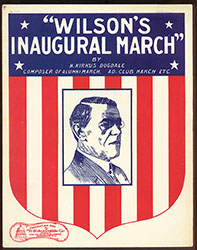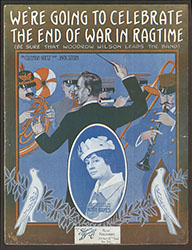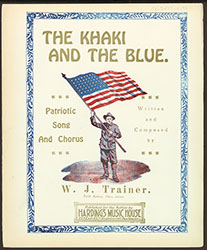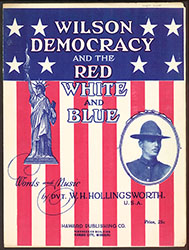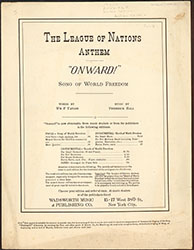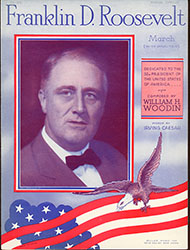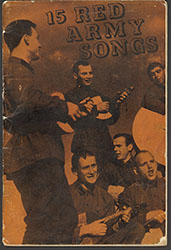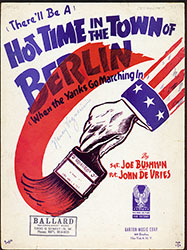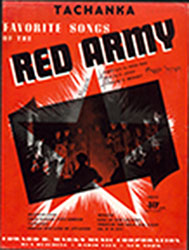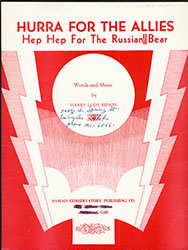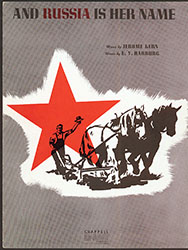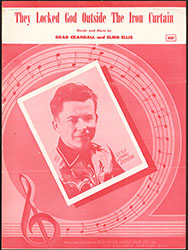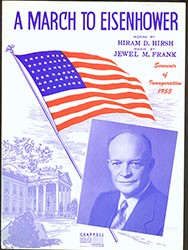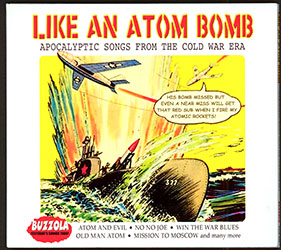
American-Soviet Relations: From Allies to the Cold War
Music can be used to express many emotions. It can also be used to express complex ideological concepts such as nationalism and the climate of international relations. The following songs represent America's deteriorating relations with Russia, then the Soviet Union. Although some works do not directly relate to the Soviet Union, such as the presidential marches, they are still indicative of their historical context. Overall, America's relationship with the USSR continuously worsened as the two superpowers felt threatened by their differences, such as those inherent in communism and capitalism, and through the nuclear arms race. The list's scope stretches from the early 1900s and ends in the 1950s.
"Wilson's Inaugural March"
Published in 1913 by H. Kirkus Dugdale in Washington, D.C.
Creator: H. Kirkus Dugdale.
CPM ID: 007293-CPMLG
Woodrow Wilson was the 28th president of the United States. He was in office from 1913 to 1921. This song celebrates his first inauguration, which occurred on March 4, 1913. In this context, American relations with Russia were neutral. During Wilson's presidency, America favored isolation and removal from the mounting tension in Europe. However, it was also during his presidency that America entered World War I. The upbeat, proud tone of this piece demonstrates Americans' belief in their president and his policies.
"We're Going to Celebrate the End of the War in Ragtime (Be Sure that Woodrow Wilson Leads the Band)"
Published in 1915 by Shapiro, Bernstein & Co. in New York, N.Y.
Creators: Coleman Goetz and Jack Stern.
CPM ID: 001409-AVERY
Although published before the end of World War I, this piece's tone is indicative of some Americans' view of the war. Lyrics such as, "Ev'ryone will feel so gay / There'll be one long holiday / When each nation claims neutrality" are hopeful and optimistic concerning the war and its outcome. Ragtime is a musical genre most popular during the late nineteenth century and early twentieth century. It featured an upbeat tempo and was typically played on the piano.
"The Khaki and the Blue"
Published in 1917 by Hardings Music House in New York, N.Y.
Words and Music by W. J. Trainer.
Arranged by Ralph Gunst.
CPM ID: 005877-UCLAS
This song stresses America's morality in WWI, which was defined in terms of fighting for freedom now and for future generations. The song also makes a clear judgment on Germany, since the text reads, "We must secure for future generations guarding, / guarding, guarding from the tyrannies of Prussian Rule." The Germans are perceived as enemies and as threats to the American way of life. In Russia, 1917 was an important year; the Russian Revolution upset the tsarist order and created a government based on communist principles.
"Wilson Democracy and the Red, White, and Blue"
Published in 1918 by Haward Publishing Co. in Kansas City, M. O.
Words and Music by W. H. Hollingsworth.
CPM ID: 001454-AVERY
As the title suggests, this piece praises President Wilson and the American soldiers who fought for the "Red, White, and Blue." At the end of World War I, American-Russian relations were strained. The transition between 1917 and 1918 was difficult for Russia, especially with the treaty of Brest-Litovsk in 1918 which pulled Russia from WWI. America, under Wilson, placed great faith in American exceptionalism and the role of democracy in the post-war countries of Eastern Europe.
"The League of Nations Anthem 'Onward!'"
Published in 1918 by Wadsworth Music and Publishing Co. in New York, N. Y.
Words by Wm. P. Taylor.
Music by Frederick Hall.
CPM ID: 007360-CPMLG
Woodrow Wilson campaigned for the ratification of the League of Nations in America, but it was rejected by Congress. The League of Nations was an international pact that sought world peace. The United States did not enter into this agreement and became more isolated, which affected its later entrance into WWII.
"Franklin D. Roosevelt: March"
Published in 1933 by Miller Music Incorporated in New York, N.Y.
Words by Irving Caesar.
Music by William H. Woodin.
CPM ID: 012044-CPMSM
Franklin D. Roosevelt was the 32nd American president. This upbeat, enthusiastic song celebrates Roosevelt's first inauguration and was considered by Roosevelt as his official march. During his term in December of 1941, America entered World War II. American-Soviet relations were disparate due to the Nazi-Soviet Nonaggression pact on August 23, 1939. However, with Germany's invasion of the Soviet Union under "Operation Barbossa," in June of 1941, the USSR began to seek alliances with other countries.
"15 Red Army Songs"
Published in 1941 by Am-Rus Music Corporation in New York, N. Y.
Creator: David J. Grunes.
CPM ID: SP-040206
The songbook's prevailing theme is the preservation and commemoration of the Russian homeland. It also shows that many Soviets were as patriotic concerning their nation as Americans were for their native country.
"There'll be a hot time in the town of Berlin"
Published in 1943 by Barton Music Corporation in New York, N.Y.
Creators: Sgt. Joe Bushkin and Pvt. John De Vries.
CPM ID: 005701-CPMSM
This song reveals who American saw as the aggressor in World War II – Germany. The lyrics claims that it will be a glorious time when the "Brooklyn boys begin / to take the joint [Berlin] apart." The USSR and its previous agreement with Germany are not mentioned. Instead, the blame of the war is situated with Germany.
"Tachanka: Favorite Songs of the Red Army"
Published in 1918 by Wadsworth Music and Publishing Co. in New York, N. Y.
Words by Wm. P. Taylor.
Music by Frederick Hall.
CPM ID: 010782-UCLAS
According to music's definition, a tachanka is "a machine gun mounted on a vehicle drawn by horses." This important piece shows that America did not view the Red Army as a threat in 1942. However, this song depicts Soviets as formidable foes. It is also important that this piece of music was translated to an English-speaking audience.
"Hurra for the Allies, Hep Hep for the Russian Bear"
Published in 1943 by Hawaii Conservatory Publishing Company in Hollywood, C. A.
Words and Music by Harry Ludy Bipson.
CPM ID: 003431-UCLAS
This music shows the Soviet Union and America as allies against the German threat. It also refers to the Battle of Stalingrad, which was a decisive Soviet victory. "Hurra for the Allies" was published before the great shift in relations which happened after FDR's death and the expansionist policies Stalin set in place after the war.
"And Russia is Her Name"
Published in 1943 by Chappell & Company, Inc. In New York, N. Y.
Creators: H. Jerome Kern and E. Y. Harburg.
CPM ID: 000267-UCLAS
The song's cover is indicative of the American understanding of Soviets before the Red Scare. The large image of the horses, plow, and farmer connects Soviets with agriculture and an idealized, rural area. The text also idealizes the USSR through its use of human qualities to describe the countryside. For example, it reads, "Her cheeks were all the cherry trees that bloom in May." These positive, rustic images largely disappear with the Cold War mindset and the antagonism between the United States and the Soviet Union.
"They Locked God Outside the Iron Curtain"
Published in 1952 by Peer International Corporation in New York, N.Y.
Words and Music by Brad Crandall and Elmo Ellis.
CPM ID: 012310-CPMSM
The Cold War began in 1947, placing the publication of this piece five years into the conflict. "They Locked God Outside the Iron Curtain" conveys the ideological imbalance between America and the USSR. The music talks about how God can't reach the Soviet because of the Iron Curtain. It condemns the USSR as a Godless nation with text such as, "There's a land where little children cannot / play, And the people have forgotten / how to pray." Such strong, suggestive language creates a sharp divide between the two countries and distinguishes the Soviet Union as the "other."
"A March to Eisenhower "
Published in 1953 by Chappell & Co. Inc. Music in New York, N.Y.
Words by Hiram D. Hirsh.
Composer: Jewel M. Frank.
CPM ID: 012801-CPMSM
This sheet music acted as a souvenir of Eisenhower's 1953 inauguration as the 34th American president. Eisenhower served as General of the Army in World War II and earned respect and recognition as a war hero. The text reveals an admiration for Eisenhower's previous military career when it reads, "From Abilene to good old West Point, / Onward to France, Ike struck like a / wall of fire."
Like an Atom Bomb: Apocalyptic Songs from the Cold War Era
Published in 2004.
Label: Buzzola Chrome Dreams.
During the Cold War, the atomic culture was created through the nuclear arms race between the two major superpowers, America and the Soviet Union. These songs convey the tension, fear, and paranoia accompanied by the threat of nuclear war.
- List of Songs
- "Jesus Hits Like An Atom Bomb" - The Pilgrim Travellers
- "Atomic Sermon" - Billy Hughes & His Buckaroos
- "Atomic Power" - The Buchanan Brothers
- "When They Dropped The Atomic Bomb" - Jackie Doll & His Pickled Peppers
- "Old Man Atom" - The Sons Of The Pioneers
- "Atom And Evil" - Golden Gate
- "No No Joe" - Hank Williams
- "Jesus Is The First Line Of Defence" - The Pilgrim Travellers
- "When The Atom Bomb Fell" - Karl & Harty
- "Win The War Blues" - Sonny Boy Williamson
- "Atomic Telephone" - Spirit Of Memphis Quartet
- "Atomic Cocktail" - Slim Gaillard
- "Fireball Boogie" - Camille Howard
- "She's Been Gone" - H-Bomb Ferguson
- "Mission To Moscow" - Benny Goodman Orchestra
- End Of War Blues - Charles Brown
- "Sad News From Korea" - Lightnin' Hopkins
- "Jesus Hits Like An Atom Bomb" - Lowell Blanchard
Conflicts between America and the Union of Soviet Socialist Republics continued during 1960s and 1970s. But with the collapse of the Soviet Union in 1989, the Cold War ended and the tension which had pervaded American-Russian relations lightened.
Further Reading and Resources:
Benvenuti, Francesco. The Bolsheviks and the Red Army 1918-1922. Cambridge: Cambridge University Press, 2009.
Boyer, Paul. By the Bomb's Early Light: American Thought and Culture at the Dawn of the Atomic Age. New York:
Pantheon Books, 1985.
Brinkley, Alan. Franklin Delano Roosevelt. Oxford: Oxford University Press, 2009.
Cooper, John Milton. Woodrow Wilson: A Biography. New York: Random House Inc., 2009.
Gaddis, John Lewis. We Now Know: Rethinking Cold War History. Oxford: Oxford University Press, 1997.
Newton, Jim. Eisenhower: The White House Years. New York: First Anchor Books Edition, 2012.
Scott, George. The Rise and Fall of the League of Nations. New York: Macmillan, 1974.
This online exhibit was curated by Elaura Highfield in collaboration with the Center for Popular Music for HIST 6535: Essentials of Museum Management.
All rights reserved.
© 2013





